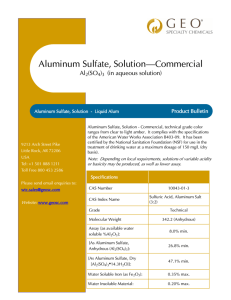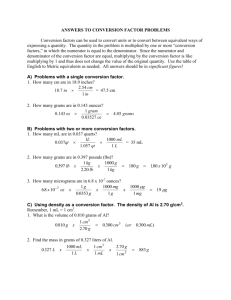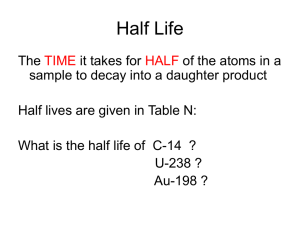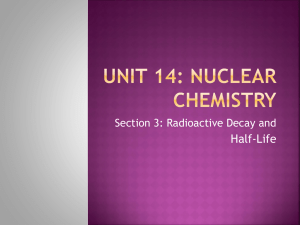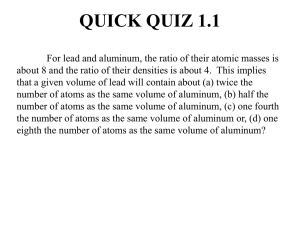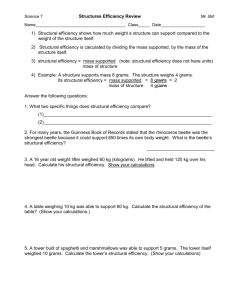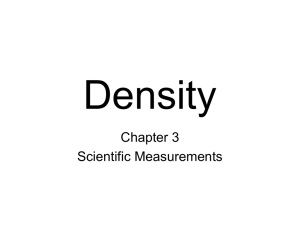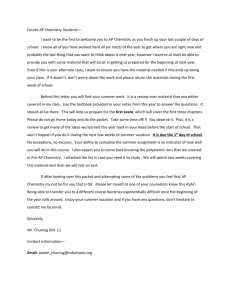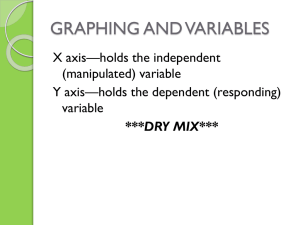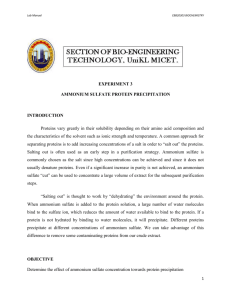Chem 1A Test Review#1 - Berkeley City College
advertisement
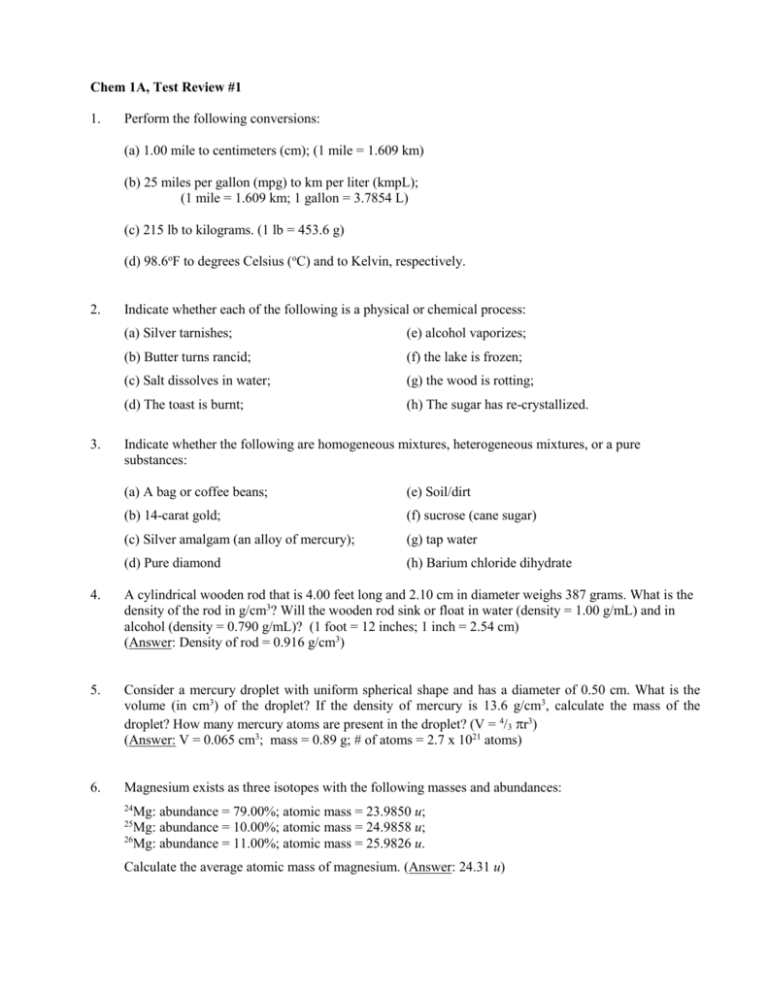
Chem 1A, Test Review #1 1. Perform the following conversions: (a) 1.00 mile to centimeters (cm); (1 mile = 1.609 km) (b) 25 miles per gallon (mpg) to km per liter (kmpL); (1 mile = 1.609 km; 1 gallon = 3.7854 L) (c) 215 lb to kilograms. (1 lb = 453.6 g) (d) 98.6oF to degrees Celsius (oC) and to Kelvin, respectively. 2. 3. Indicate whether each of the following is a physical or chemical process: (a) Silver tarnishes; (e) alcohol vaporizes; (b) Butter turns rancid; (f) the lake is frozen; (c) Salt dissolves in water; (g) the wood is rotting; (d) The toast is burnt; (h) The sugar has re-crystallized. Indicate whether the following are homogeneous mixtures, heterogeneous mixtures, or a pure substances: (a) A bag or coffee beans; (e) Soil/dirt (b) 14-carat gold; (f) sucrose (cane sugar) (c) Silver amalgam (an alloy of mercury); (g) tap water (d) Pure diamond (h) Barium chloride dihydrate 4. A cylindrical wooden rod that is 4.00 feet long and 2.10 cm in diameter weighs 387 grams. What is the density of the rod in g/cm3? Will the wooden rod sink or float in water (density = 1.00 g/mL) and in alcohol (density = 0.790 g/mL)? (1 foot = 12 inches; 1 inch = 2.54 cm) (Answer: Density of rod = 0.916 g/cm3) 5. Consider a mercury droplet with uniform spherical shape and has a diameter of 0.50 cm. What is the volume (in cm3) of the droplet? If the density of mercury is 13.6 g/cm3, calculate the mass of the droplet? How many mercury atoms are present in the droplet? (V = 4/3 r3) (Answer: V = 0.065 cm3; mass = 0.89 g; # of atoms = 2.7 x 1021 atoms) 6. Magnesium exists as three isotopes with the following masses and abundances: 24 Mg: abundance = 79.00%; atomic mass = 23.9850 u; Mg: abundance = 10.00%; atomic mass = 24.9858 u; 26 Mg: abundance = 11.00%; atomic mass = 25.9826 u. 25 Calculate the average atomic mass of magnesium. (Answer: 24.31 u) 7. 8. 9. Name each of the following compounds: (a) H3PO4 : _______________________; (e) B2O3 : _______________________; (b) (NH4)2SO4: ___________________; (f) Ni(NO3)2 :_____________________; (c) SF6 :_________________________; (g) PbCrO4:_______________________; (d) HC2H3O2: _____________________; (h) CaCO3: _______________________ Write the correct formula of each of the following compounds: (a) calcium fluoride: ___________; (e) ammonium nitrate:__________ (b) Potassium dichromate: ________; (f) dinitrogen pentoxide:________ (c) Copper(II) sulfate: ________; (g) Nitric acid: _______ (d) Hydrosulfuric acid: _______; (h) Iron(III) oxide: _______ Write a balanced chemical equation for each reaction described below: (a) Solid ammonium carbonate decomposes when heated to yield ammonia gas, carbon dioxide gas, and water vapor. (b) Calcium metal reacts with water to produce hydrogen gas and calcium hydroxide solution. 10. Balance the following chemical equations. O2(g) (a) C4H10O(l) + (b) NH3(g) + O2(g) (c) Ca3P2(s) + H2O(l) CO2(g) + NO(g) + H2O(g); H2O(g); Ca(OH)2(aq) + PH3(g); 11. An element E forms an oxide with formula E2O3. If the combining ratio of the masses is 8.708 g of element E to 1.000 g of oxygen, calculate the relative atomic mass of E and determine its identity. The relative atomic mass of oxygen is 16.00 u. (Answer: 209.0 u = Bi) 12. Calculate the mass percentages of nitrogen and phosphorus, respectively, in ammonium phosphate, (NH4)3PO4. (b) How many grams of ammonium phosphate contain 128 grams of nitrogen? (c) How many grams of phosphorus are present in a sample of ammonium phosphate that contains 128 g of nitrogen. (Answer: (a) %N = 28.19%; %P = 20.77%; (b) 454 g (NH4)3PO4; (c) 94.3 g P) 13. Write the empirical formula of each of the following compounds: (a) C4H8O2 (b) C6H6 (c) C2H6N2O (d) C6H4Br2 (e) C3H6O3 14. A compound is composed of 62.04% carbon, 10.41% hydrogen, and 27.55% oxygen, by mass. (a) Determine its empirical formula. (b) If the molecular mass of the compound is 116.2 u, determine its molecular formula. (Answer: (a) C3H6O; (b) C6H12O2) 15. Aluminum sulfate, Al2(SO4)3, an important product in water treatment, is produced by the following reaction of aluminum oxide with sulfuric acid: Al2O3(s) + 3 H2SO4(aq) Al2(SO4)3(s) + 3 H2O(l) (a) If 454 g of aluminum oxide, Al2O3, are reacted with 1.20 kg of sulfuric acid, which reactant is the limiting reagent? (b) When all of the limiting reagent is completely reacted, how many grams of Al 2(SO4)3 are produced? (Answer: 1.40 kg) (c) How many grams of the other reactant are reacted when the limiting reagent has been completely consumed, and how many grams of this reactant remain unreacted at the end of the reaction? (Answer: 416 g of Al2O3 reacted and 38 g unreacted) (d) If 1.30 kg of aluminum sulfate were actually obtained, what is the percentage yield? (Answer: 92.9% yield) (e) How many grams of aluminum oxide must be reacted with an excess of H2SO4 to produce 1.00 kg of Al2(SO4)3 if the reaction is 95.0% efficient (that is, the reaction gives 95.0% yield. (Ans: 314 g) 16. Aluminum sulfate is also formed when aluminum metal is reacted with dilute sulfuric acid according to the following reaction, in which hydrogen gas is a by-product: 2 Al(s) + 3 H2SO4(aq) Al2(SO4)3(aq) + 3 H2(g) (a) How many grams of aluminum sulfate, Al2(SO4)3, will be formed if 135.0 g of aluminum metal are completely reacted with excess sulfuric acid if: (i) the yield is 100%; (ii) the yield is 91.5%? (b) How many grams of aluminum mus (Ans.: (a) (i) 856.0 g; (ii) 783 g) 17. Determine the percent (by mass) of sugar in a solution that contains 35.0 g of sugar dissolved in 100.0 g of water. (Answer: 25.9%) 18. Seawater contains 3.5% salt (NaCl) by mass percent. How many grams of salt will be obtained if 5.00 gallons of seawater is completely evaporated? (Assume the density of seawater = 1.0 g/mL; 1 gallon = 3785.4 mL) (Answer: 660 g) 19. A solution is prepared by dissolving 25.0 g of sodium sulfate decahydrate, Na 2SO410H2O, in enough water to make 250.0 mL solution. Calculate the molarity of the sodium sulfate solution. (Answer: 0.310 M) 20. How many grams of sodium sulfate decahydrate, Na2SO410H2O, are required to make 250.0 mL of 0.200 M solution? (Answer: 16.1 g)

